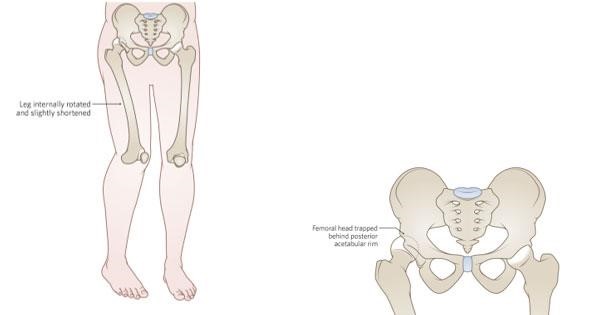A client is brought to the emergency department by ambulance after stepping in a hole and falling. During the assessment, the nurse notes that the right leg is shorter than the left leg the right hip is noticeably deformed and acute pain is noted. Imaging does not reveal a fracture. What is the most likely explanation for this client's signs and symptoms?
Right hip dislocation
Right hip contusion
Right hip strain
Right hip osteoarthritis
The Correct Answer is A
A. Right hip dislocation: In a hip dislocation, the head of the femur is forced out of the acetabulum, which is the socket in the pelvis. This can cause a noticeably shorter leg, hip deformity, and acute pain. Imaging might not show a fracture in the case of a dislocation.
B. Right hip contusion: A hip contusion is a bruise on the hip, usually caused by a direct blow or trauma. While it can cause pain and swelling, it typically does not result in a noticeably shorter leg or hip deformity.
C. Right hip strain: Hip strain refers to damage to the muscles or tendons around the hip joint due to overuse or sudden twisting movements. While it can cause pain, it does not typically lead to a noticeable leg shortening or hip deformity.
D. Right hip osteoarthritis: Osteoarthritis is a degenerative joint disease that can affect the hip joint. It leads to joint pain and stiffness but does not usually cause a noticeable leg shortening or acute deformity unless there are severe complications, which are not mentioned in the scenario.

Nursing Test Bank
Naxlex Comprehensive Predictor Exams
Related Questions
Correct Answer is C
Explanation
A. Apply cold compress to the client's flank area - Applying a warm compress, not a cold one, to the flank area can help alleviate pain associated with urolithiasis. Heat can promote muscle relaxation and increase blood flow to the area, potentially easing discomfort.
B. Restrict protein intake to 2 servings per day - There is no direct connection between protein intake and urolithiasis. However, specific dietary recommendations may vary based on the type of kidney stones a person has. For example, individuals with certain types of stones might be advised to limit oxalate-rich foods. It's essential to tailor dietary advice based on the composition of the stones.
C. Encourage intake of at least 3 L of fluids per day - Adequate fluid intake, particularly water, is crucial for preventing the formation of kidney stones. Increased fluid intake can help dilute substances in the urine that contribute to stone formation, reducing the risk of stone recurrence.
D. Discourage ambulation - Encouraging ambulation and movement is generally beneficial for patients with urolithiasis. Movement can help alleviate discomfort, prevent complications such as blood clots, and promote overall well-being. Restricting movement unnecessarily is not advisable.
Correct Answer is D
Explanation
A. Increased urinary output: Phenazopyridine (Pyridium) does not directly impact urinary output. Its primary function is to provide relief from urinary pain, burning, and discomfort associated with urinary tract infections (UTIs) or other urinary conditions. It does not affect the amount of urine a person produces.
B. Decreased WBC's: Phenazopyridine does not directly influence white blood cell count (WBCs). WBC count is an indicator of the body's immune response and is typically used to assess the presence of infection. Phenazopyridine provides symptomatic relief but does not affect the underlying infection or the body's immune response to it.
C. Increased uric acid: Phenazopyridine does not affect uric acid levels. Uric acid is a waste product that is excreted by the kidneys. Elevated uric acid levels can be associated with conditions like gout, but Phenazopyridine does not have any direct impact on these levels.
D. Decreased bladder pain/spasms: Phenazopyridine is intended to relieve symptoms such as bladder pain, spasms, burning sensation, and discomfort experienced during urination. Therefore, the effectiveness of Phenazopyridine is indicated by a reduction in these symptoms. If the patient reports a decrease in bladder pain and spasms, it suggests that the medication is working to alleviate the discomfort associated with urinary tract issues.
Whether you are a student looking to ace your exams or a practicing nurse seeking to enhance your expertise , our nursing education contents will empower you with the confidence and competence to make a difference in the lives of patients and become a respected leader in the healthcare field.
Visit Naxlex, invest in your future and unlock endless possibilities with our unparalleled nursing education contents today
Report Wrong Answer on the Current Question
Do you disagree with the answer? If yes, what is your expected answer? Explain.
Kindly be descriptive with the issue you are facing.
